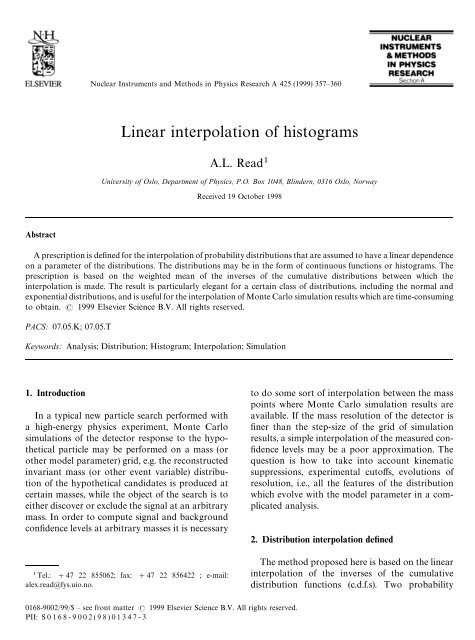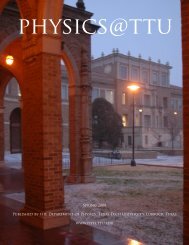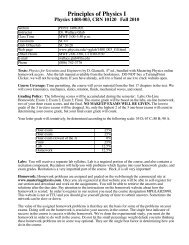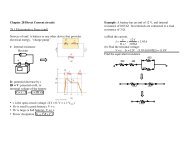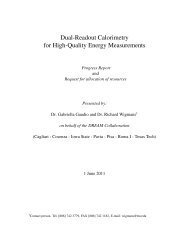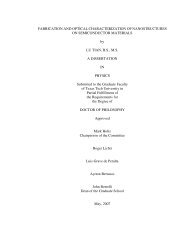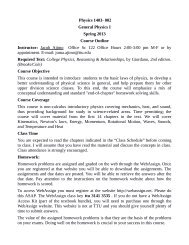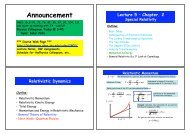Linear interpolation of histograms
Linear interpolation of histograms
Linear interpolation of histograms
You also want an ePaper? Increase the reach of your titles
YUMPU automatically turns print PDFs into web optimized ePapers that Google loves.
Nuclear Instruments and Methods in Physics Research A 425 (1999) 357—360<br />
<strong>Linear</strong> <strong>interpolation</strong> <strong>of</strong> <strong>histograms</strong><br />
A.L. Read<br />
University <strong>of</strong> Oslo, Department <strong>of</strong> Physics, P.O. Box 1048, Blindern, 0316 Oslo, Norway<br />
Received 19 October 1998<br />
Abstract<br />
A prescription is defined for the <strong>interpolation</strong> <strong>of</strong> probability distributions that are assumed to have a linear dependence<br />
on a parameter <strong>of</strong> the distributions. The distributions may be in the form <strong>of</strong> continuous functions or <strong>histograms</strong>. The<br />
prescription is based on the weighted mean <strong>of</strong> the inverses <strong>of</strong> the cumulative distributions between which the<br />
<strong>interpolation</strong> is made. The result is particularly elegant for a certain class <strong>of</strong> distributions, including the normal and<br />
exponential distributions, and is useful for the <strong>interpolation</strong> <strong>of</strong> Monte Carlo simulation results which are time-consuming<br />
to obtain. 1999 Elsevier Science B.V. All rights reserved.<br />
PACS: 07.05.K; 07.05.T<br />
Keywords: Analysis; Distribution; Histogram; Interpolation; Simulation<br />
1. Introduction<br />
In a typical new particle search performed with<br />
a high-energy physics experiment, Monte Carlo<br />
simulations <strong>of</strong> the detector response to the hypothetical<br />
particle may be performed on a mass (or<br />
other model parameter) grid, e.g. the reconstructed<br />
invariant mass (or other event variable) distribution<br />
<strong>of</strong> the hypothetical candidates is produced at<br />
certain masses, while the object <strong>of</strong> the search is to<br />
either discover or exclude the signal at an arbitrary<br />
mass. In order to compute signal and background<br />
confidence levels at arbitrary masses it is necessary<br />
Tel.: #47 22 855062; fax: #47 22 856422 ; e-mail:<br />
alex.read@fys.uio.no.<br />
to do some sort <strong>of</strong> <strong>interpolation</strong> between the mass<br />
points where Monte Carlo simulation results are<br />
available. If the mass resolution <strong>of</strong> the detector is<br />
finer than the step-size <strong>of</strong> the grid <strong>of</strong> simulation<br />
results, a simple <strong>interpolation</strong> <strong>of</strong> the measured confidence<br />
levels may be a poor approximation. The<br />
question is how to take into account kinematic<br />
suppressions, experimental cut<strong>of</strong>fs, evolutions <strong>of</strong><br />
resolution, i.e., all the features <strong>of</strong> the distribution<br />
which evolve with the model parameter in a complicated<br />
analysis.<br />
2. Distribution <strong>interpolation</strong> defined<br />
The method proposed here is based on the linear<br />
<strong>interpolation</strong> <strong>of</strong> the inverses <strong>of</strong> the cumulative<br />
distribution functions (c.d.f.s). Two probability<br />
0168-9002/99/$ — see front matter 1999 Elsevier Science B.V. All rights reserved.<br />
PII: S 0 1 6 8 - 9 0 0 2 ( 9 8 ) 0 1 3 4 7 - 3
358 A.L. Read / Nuclear Instruments and Methods in Physics Research A 425 (1999) 357—360<br />
distribution functions (p.d.f.s) for the observable x, 3. Interpolating distributions <strong>of</strong> the form g((xx o )/k)<br />
fM (x)" f (x ) f (x )<br />
af (x )#bf (x ) . (8) fM (x)"g x!xN <br />
kM <br />
. (18)<br />
f (x) and f (x) (defined in the physical region<br />
<br />
x5!R), have corresponding c.d.f.s<br />
The prescription for linear <strong>interpolation</strong> <strong>of</strong> p.d.f.s<br />
defined in Eqs. (4)—(6) takes a particularly elegant<br />
F (x)" (x)dx, (1)<br />
form when the initial p.d.f.s can both be described<br />
by the same function with different arguments <strong>of</strong><br />
f<br />
F (x)" a particular form. Suppose that<br />
(x)dx. (2)<br />
<br />
f<br />
f (x)"g <br />
The goal is to obtain a new p.d.f. fM (x) with its<br />
<br />
k <br />
, (9)<br />
corresponding c.d.f.<br />
f (x)"g<br />
FM (x)" <br />
fM <br />
k <br />
, (10)<br />
(x)dx (3)<br />
G<br />
that describe the new distribution. The first step <strong>of</strong><br />
<br />
k <br />
" g<br />
<br />
dx, (11)<br />
k <br />
<br />
the <strong>interpolation</strong> procedure is to find x and where x and k regulate the <strong>of</strong>fset and scale features<br />
<strong>of</strong> p.d.f. i. Eq. (4) takes the form<br />
<br />
<br />
x where the cumulative distributions F and<br />
F are equal for a given cumulative probability y,<br />
<br />
G<br />
F (x )"F (x )"y. (4)<br />
!x <br />
k <br />
"G x !x "y. (12)<br />
k <br />
<br />
The cumulative probability for the new distribution<br />
FM is set to the same value y at a linearly interpolated<br />
This implies that the arguments in Eq. (12) have the<br />
same value λ,<br />
position x,<br />
FM (x)"y, (5)<br />
λ" x !x " !x . k k <br />
(13)<br />
x"ax #bx . <br />
(6) Substitution <strong>of</strong> these results in Eq. (5) yields<br />
The constants a and b express the <strong>interpolation</strong> FM (x)"G(λ), (14)<br />
distance between the extreme values <strong>of</strong> the relevant<br />
parameter for the two existing distributions (and by<br />
construction satisfy a#b"1). For a new particle<br />
search, for instance, this could be the relative position<br />
i.e. the same function describes both the initial and<br />
the interpolated cumulative distributions. Substitution<br />
in Eq. (6) yields<br />
<strong>of</strong> the mass hypothesis between two masses for<br />
which the observable invariant mass distributions λ" x!x , have been computed in a Monte Carlo simulation.<br />
kM<br />
(15)<br />
The p.d.f. fM (x) is obtained by inverting the cumulative<br />
distributions in Eqs. (4) and (5), substituting<br />
these results in Eq. (6),<br />
where<br />
xN<br />
"ax #bx , (16)<br />
FM (y)"aF<br />
(y)#bF (y),<br />
<br />
(7) kM "ak #bk . <br />
(17)<br />
deriving this with respect to y and solving for the<br />
interpolated p.d.f. fM (x),<br />
The interpolated p.d.f. fM (x) is then obtained by<br />
derivation <strong>of</strong> G(λ),
A.L. Read / Nuclear Instruments and Methods in Physics Research A 425 (1999) 357—360 359<br />
Fig. 1. Example <strong>of</strong> histogram <strong>interpolation</strong>. The reconstructed invariant mass distribution for a 60 GeV/c Higgs (solid line) has been<br />
obtained by <strong>interpolation</strong> between the simulation results for 50 (dotted line) and 70 (dash-dotted line) GeV/c Higgs masses and is<br />
overlaid with the simulation results <strong>of</strong> a 60 GeV/c Higgs (dashed line).<br />
This means, for instance, that if both initial p.d.f.s<br />
are normal distributions, the interpolated distribution<br />
is also a normal distribution with both<br />
the variance and mean linearly interpolated<br />
between those <strong>of</strong> the initial distributions. For<br />
exponential decay distributions (x <br />
"0,k(0)<br />
the decay constant <strong>of</strong> the interpolated distribution<br />
is linearly interpolated between the decay constants<br />
<strong>of</strong> the initial distributions. The same elegant<br />
result is also obtained whenever both initial<br />
distributions can be described by the same<br />
power series in (x!x <br />
)/k <br />
.<br />
between the 3 mass distributions (these distributions<br />
were chosen to illustrate the <strong>interpolation</strong><br />
precisely because they have several, rapidly evolving<br />
features which could be difficult to interpolate).<br />
Since the <strong>interpolation</strong> is able to predict so well the<br />
main features <strong>of</strong> the 60 GeV/c simulation results, it<br />
is plausible that the smaller <strong>interpolation</strong> distances<br />
(42.5 GeV/c) used in the DELPHI Higgs search<br />
will lead to results superior to those obtained by<br />
more simple means (for example simply using the<br />
nearest available distribution or shifting it by<br />
the difference between the mass hypothesis and the<br />
simulated mass).<br />
4. Interpolation <strong>of</strong> <strong>histograms</strong><br />
For a pair <strong>of</strong> initial distributions obtained by<br />
histogramming the output <strong>of</strong> a complex physics<br />
and detector simulation, it may not be practical to<br />
identify a particular function which can describe<br />
both initial distributions, but it is always possible<br />
to carry out the computation in Eqs. (4)—(8)<br />
on the <strong>histograms</strong> directly in order to obtain an<br />
interpolated histogram. Fig. 1 shows how well the<br />
<strong>interpolation</strong> procedure manages to describe the<br />
reconstructed invariant mass distribution <strong>of</strong> a<br />
hypothetical Standard Model Higgs boson with<br />
mass m <br />
"60 GeV/c decaying in the<br />
ZHPeeH channel at center-<strong>of</strong>-mass energy<br />
s"161 GeV based on simulations at m <br />
" 50<br />
and 70 GeV/c [1], despite the large differences<br />
5. Conclusion<br />
A method for linearly interpolating probability<br />
distribution functions or <strong>histograms</strong> has been presented<br />
here. The method gives particularly intuitive<br />
results for certain well-known probability distribution<br />
functions, such as the normal distribution,<br />
where the mean and variance parameters are simply<br />
linearly interpolated between those <strong>of</strong> the initial<br />
pair <strong>of</strong> distributions. The method can also be applied<br />
to histogrammed simulation data where the<br />
distribution functions are not known and are very<br />
different from each other, and surprisingly reasonable<br />
results may be obtained.
360 A.L. Read / Nuclear Instruments and Methods in Physics Research A 425 (1999) 357—360<br />
Acknowledgements<br />
This work was supported by a grant from the<br />
Norwegian Research Council. I would like to thank<br />
my DELPHI colleagues for permission to use their<br />
published Higgs search simulation results to illustrate<br />
the histogram <strong>interpolation</strong>.<br />
References<br />
[1] DELPHI Collaboration, Search for neutral and charged<br />
Higgs bosons in ee collisions at s"161 GeV and<br />
172 GeV, Eur. Phys. J. C 2 (1998) 1.


